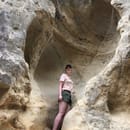In an Instagram post from Jan. 6, Benefit Cosmetics announced its recruitment of 20-year-old Irish woman, Kate Grant, as its new brand ambassador for their Roller Liner Matte Liquid Eyeliner. Grant’s appearance has garnered over 5,000 likes and is receiving a sweep in media attention.
Aside from her stunning looks, why has the media been swept into a frenzy over Grant exactly?
It’s because she has Down Syndrome.
As defined by the National Down Syndrome Society, Down Syndrome occurs in individuals when they have a “full or partial copy of chromosome 21.” Common physical traits of Down Syndrome are “low muscle tone, small stature, an upward slant to the eyes and a single deep crease across the center of the palm”, but it does present differently in all individuals. `
Not unlike how people choose language to differentiate their sexuality or gender identity, there are lots of different terms people choose to utilize when describing and identifying with their disability. This is not to say that labels are wrong, just that people choose to identify as they wish.
Personally, I am not a fan of any label in the “dis”abled community. “Disability” implies imperfection and limitation, along with other negative connotations. We all have limitations: some are just more obvious. Others choose to change this to “differently abled,” removing the negativity associated with the “dis” prefix entirely. I choose to highlight capabilities and differences by utilizing the term “accessibility needs” — an abbreviation of the former term if you will.
However one chooses to identify, we can usually all agree on one thing: we are ourselves first and our disabilities are second. This is something the media and beauty industry like to distort in an attempt to continue their linear classification of people. Terms like “disabled model” or “plus-sized model” are indicative of this. Whether you are a fan of the terms or not, I think it’s a little odd that we have to differentiate peoples’ abilities or characteristics if they are performing the same job.
So what exactly defines “beauty” in the beauty industry?
Some may argue a literal perspective and describe nature. Sunsets, flowers and waterfalls come to mind. Others think of more concrete definitions in relation to a person, like physique, eye colour and hairstyle. What is evident from this is that beauty is subjective.
When one thinks of the modern beauty industry, a certain type of “look” is often imagined. A particular appearance and body type has been idealized for mass consumption and is present in nearly all advertisements, from clothing to cosmetics. This look’s commodification has contributed to a warped perception on the “normalized” look people should and can achieve via the purchasing of such products.
Thankfully, individuals like Grant shine a bright light on motivating the beauty industry in its continued quest for diversity and inclusion. Past trailblazers include the likes of Ashley Graham and Winnie Harlow. Aside from growing diversity in body type and ethnicity, one demographic seems to be continuously neglected: the disabled community.
In an article from The Sun, disability activist Beth Wilson captured this dilemma perfectly with a post regarding a bridal shop in Portishead, Somerset. Wilson’s caption was as follows: “The new wedding shop in town has a wheelchair using mannequin and it shouldn’t be exciting but it’s the first time I’ve ever seen disability portrayed in a shop window.”
I cannot agree with Wilson more: “it shouldn’t be exciting” to have a mannequin use a wheelchair — or to have Grant as a brand ambassador. It should be standard.
Representation in media of any kind is so important. It makes individuals feel heard, valued and important. It’s a reminder to the greater world that we exist and face challenges, but are not unable to achieve success.
Over the past year, some companies have been paying attention to this. Aerie is particularly noteworthy. With the launch of the #AerieREAL campaign in 2018, Aerie has made a promise to feature diverse models of all shapes, sizes and colours, without retouching their ads. Models include those with disability, chronic illness and mobility devices. Individuals include Abby Sams, Rajee Aerie, Evelyn Riddell and Gaylyn Henderson. Previous to this, 2015’s New York Fashion Week (NYFW) featured model Madeline Stuart.
As for Grant herself, in an article by The Mighty, it is clear this past year has been an eventful one. Grant was crowned “Teen Ultimate Beauty of the World,” walked the catwalk for Belfast Fashion Week, and appeared on the United Kingdom (UK) show, “This Morning.” Grant also appeared in BBC One Northern Ireland’s documentary, True North: Role Model. One thing is for certain, Grant has set the beauty industry on fire. I know she will continue to achieve great things.
So thank you, Grant, for continuing to advocate for representation of people with disabilities via the beauty industry. Your work leaves us feeling more empowered and beautiful. You and others are going to help change the narrative surrounding the beauty industry. For that, I am forever grateful.



